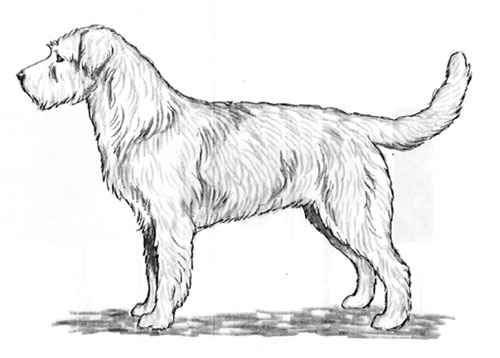Dutch Smoushond
Terrier Group
The goals and purposes of this breed standard include: to furnish guidelines for breeders who wish to maintain the quality of their breed and to improve it; to advance this breed to a state of similarity throughout the world; and to act as a guide for judges.
Breeders and judges have the responsibility to avoid any conditions or exaggerations that are detrimental to the health, welfare, essence and soundness of this breed, and must take the responsibility to see that these are not perpetuated.
Any departure from the following should be considered a fault, and the seriousness with which the fault should be regarded should be in exact proportion to its degree and its effect upon the health and welfare of the dog and on the dog’s ability to perform its traditional work.
History
The exact origins of the Smoushond are unknown. The breed was popular in the late 1800’s as a gentleman’s companion, but World War II pushed it near extinction. In the 1970’s a Mrs. H.M. Barkman began collecting information on the breed and was able to recreate it through selective breeding. Today it breeds true for both type and temperament. The breed is hardly known outside of the Netherlands.
The Dutch Smoushond was recognized by the United Kennel Club in 2006.
General Appearance
Rough coated, lively, active and squarely built, formerly known as a gentleman’s stable dog or coach dog.
Characteristics
Affectionate, gay and friendly, the breed makes an excellent companion.
Head
The head is a breed typical feature. Seen from above it is broad and short.
SKULL
The skull is slightly domed, and the forehead is slightly rounded. The stop is distinct.
MUZZLE
The muzzle is one half the length of the skull, with full, strong jaws. The lips are thin and tight and have black rims.
TEETH
The Dutch Smoushond has a complete set of evenly spaced, white teeth meeting in a scissors, level or slightly undershot bite.
NOSE
Black and broad.
EYES
The eyes are large, dark and round, with dark rims and a friendly, lively expression.
EARS
The ears are high set and drop, with the front edge close to the cheeks. They are small, thin and triangular with slightly rounded tips.
Neck
Short and muscular.
Forequarters
The forequarters are moderately angulated.
FORELEGS
Straight, not too close together, fairly well under the body, with strong, oval bone.
Body
The body must give the impression of sturdiness. Both ranginess and coarseness are frowned upon. The chest is broad and not unduly deep, with well sprung ribs. The back is broad, muscular and straight. The loin is slightly arched, and the croup is well muscled. There is very little tuck up.
Hindquarters
The hindquarters are moderately angulated, strong and muscular.
HIND LEGS
The hocks are well let down.
Feet
Round, neat and small, with dark nails.
Tail
Undocked, rather short and carried gaily, but not curled over the back.
Coat
The coat is a very important feature. On the body, it is coarse, wiry, harsh and straight, and has an unkempt appearance. It is 1.5 to 2.5 inches long. There is sufficient undercoat. Any tendency to mat is a serious fault. A part down the middle of the back indicates that the coat is too long and soft. On the legs, the coat is medium length and not dense, pointing backwards, suggesting feathering. A dense, woolly coat all over the legs that hides the outline is a fault. The coat on the tail is bushy without fringe. On the head the coat is wiry like on the body, but slightly shorter. The eyebrows should not hide the eyes and there should not be a topknot or a part on the head. The hair on the ears is shorter.
Color
Self-colored yellow in all shades, with a preference for dark straw color. Ears, moustache, beard and eyebrows may be a darker shade than the rest of the coat.
Disqualification: Any color other than yellow.
Height and Weight
Height at the withers is between 14 and 16.5 inches. Weight is 20 to 22 pounds.
Gait
Not mentioned in FCI standard.
Disqualifications
(A dog with a Disqualification must not be considered for placement in a conformation event, and must be reported to UKC.)
Unilateral or bilateral cryptorchid.
Viciousness or extreme shyness.
Albinism.
Any color other than yellow.

Looking for a Dog?
Find a dog that will fit your family.
Note: The breeders on this list are not endorsed by UKC.
©Copyright 2006, United Kennel Club
